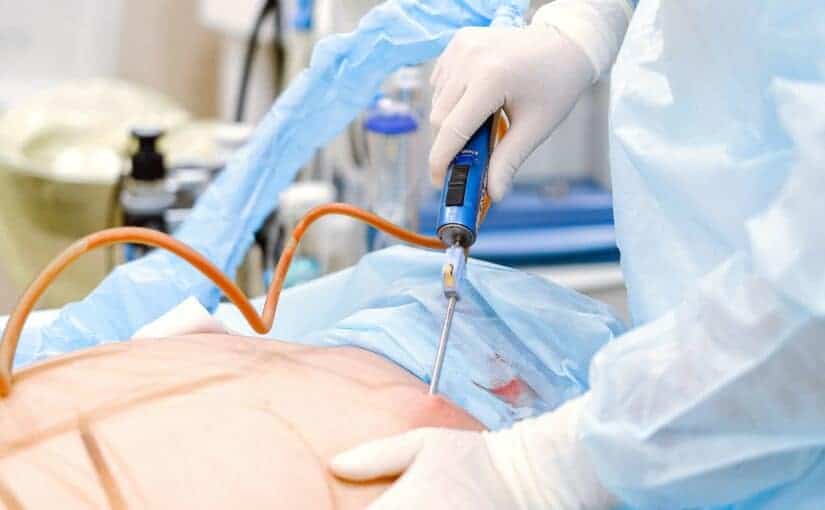Understanding Post-Liposuction Tissue Changes: Causes, Symptoms, and Treatments
Key Takeaways
-
Fibrosis is a common, unwanted result of surgical trauma experienced during liposuction surgery. This immune response leads to tissue thickening and scarring which can impact healing and alter the body’s contours.
-
Spotting fibrosis symptoms early is key. Detecting firm nodules and irregular skin surfaces is essential to treat the disease and minimize long-term damage.
-
Following these important post-operative care guidelines, such as getting adequate rest and wearing post-operative compression garments, can greatly reduce the chances of developing fibrosis.
-
Adequate hydration and a slow, managed return to low-impact activities can help tissues heal properly to improve recovery and performance.
-
You can stay on top of fibrosis with good treatment measures ranging from massage therapy and laser treatments to medications. In more serious cases, doctors can suggest surgical options.
-
Have realistic expectations about the recovery process and be prepared to make lifestyle changes. Focus on healthy eating habits and enough sleep to get the best results after liposuction.
The anatomy of post-liposuction tissue changes can be daunting to comprehend. Fibrosis frequently develops post-liposuction. It occurs when the body overreacts to an inflammatory process.
The better we can recognize the signs, the better we can manage it. Here’s what you need to know to avoid and reverse these changes with expert precision. We provide advice from our experiences on how to recover.
Understanding symptoms and taking steps to change lifestyle habits helps to accelerate the healing process. It’s our aim to demystify this process so that you understand what to expect.
We talk you through your post-surgery stage with clear and concise information. In doing so, you will lay the groundwork for a more seamless recovery experience.
What is Fibrosis?
Definition of Fibrosis
Fibrosis occurs when connective tissues become thickened and scarred due to injury or inflammation. It’s characterized by the thickening and scarring of tissue, which can severely affect the body’s ability to heal. This condition occasionally occurs post-operatively, such as after liposuction, and is able to drastically alter skin and body contours.
Awareness of fibrosis as a potential complication of treatment is key. It also assists patients in realizing there’s a reason healing isn’t as rapid. Although fibrosis is inevitable, being aware of it allows you to better prepare and adjust your expectations in the recovery process.
Causes of Fibrosis After Liposuction
Chronic surgical trauma and inflammation are the two main factors leading to fibrosis following liposuction [4]. The problem is that the procedure itself can set off an aggressive healing response in the body, resulting in fibrosis. Worse surgical technique could also lead to heightened risk.
Other things come into play too, such as genetic factors and how each individual person heals. Some people might be more susceptible to forming fibrous tissue based on other factors. As you can see, these causes are so important to be aware of in order to understand how the healing process works and what we can expect.
How Fibrosis Develops Post-Surgery
The body’s natural response to healing is where fibrosis formation begins. After surgeries like liposuction, the body heals in phases, during which scar tissue collagen accumulates in the affected tissues, leading to increased stiffness. This hardening can cause persistent lumps to form, making lipo complications a concern for many patients.
Even though most patients experience a dramatic improvement in just days after treatment for lipo fibrosis, the healing continues for months. With consistent care, you’ll see significant improvement in 1-3 months. If firm nodules persist, this could indicate fibrosis development, which requires attention.
For some, it can take months before turning the corner, while others notice changes in just a few weeks. If left untreated, the progression of fibrosis can take several years, underscoring the importance of proper liposuction care.
Symptoms of Post-Liposuction Fibrosis
After liposuction, identifying the symptoms of fibrosis is key to the best recovery. Typical symptoms of sarcoidosis are firm lumps under the skin, which can start out as tiny blemish-like nodules.
These lumps frequently lead to the development of an unsightly uneven skin texture, as the skin’s surface appears bumpy rather than clear and smooth. Constant swelling is another sign, which can be caused by lymphedema, when lymph fluid builds up in the body.
Focusing on these symptoms in the recovery phase is critically important because they inform healthcare providers on how to best address complications if and when they arise.
People experience symptoms very differently, based on the in-depthness of the surgery and individual recovery. Some people may feel only a little tightness in the area that’s been injected, while others may have chronic soreness or tenderness.
Typically, swelling resolves over the ensuing weeks and months. If hard lumps continue to appear one to three months after surgery, that can be a sign of fibrosis. When it comes to managing and monitoring recovery, early detection and monitoring makes all the difference.
Identifying Early Signs
-
Tenderness in the liposuction area
-
Localized swelling that doesn’t feel like typical post-operative swelling.
-
Changes in skin texture, feeling more firm or rigid
It’s vital for patients to be on the lookout for these warning signs. Noticing alterations in skin texture and firmness can help detect early signs of potential fibrosis.
Identifying these symptoms early is critical to proper management and avoiding long-term damage.
Common Physical Changes
Physical changes such as lumpy spots may appear, distorting the final appearance of the liposuction. These modifications may change the assumed uniformity of the body shapes, which may be very smooth.
It’s critical to not only invest in these areas but also monitor their recovery closely to achieve optimal outcomes.
When to Seek Medical Advice
-
Severe or increasing pain
-
Sudden changes in swelling patterns
-
Concerns about prolonged or worsening symptoms
It is essential to communicate any observable issues with your provider as soon as possible. Early intervention for developing complications can prevent further advancement of fibrosis.
Most patients see relief almost immediately after treatment for lipo fibrosis, and catching it early will lead to a more pleasant healing journey.
Prevention Strategies for Fibrosis
It is vital to understand how to minimize the risk of developing fibrosis after liposuction surgery. Following some simple guidelines can significantly aid in fibrosis reduction and ensure a fast recovery. Here are some strategies to consider.
1. Follow Post-Operative Instructions
The most important thing to do is listen to your surgeon’s advice. Here’s what you should do:
-
Rest adequately: Give your body time to heal.
-
Proper wound care: Keep incisions clean and dry.
-
Regular massage: Techniques like MLD can aid lymphatic drainage.
-
Take supplements: Support healing with daily vitamins or minerals.
-
100% oxygen therapy: Think hyperbaric chamber sessions for accelerated therapy.
Strict adherence to these guidelines can cut the risk of fibrosis by more than half. These are not mere suggestions—they’re critical steps in making sure our recovery will go as smoothly as possible.
2. Maintain Proper Hydration
Water is the foundation of wellness, the main ingredient in healing. It plays a role in protecting against inflammation and maintaining tissue health. Staying properly hydrated every day helps aid the recovery process and may even improve skin elasticity and texture.
Staying well hydrated is one of the easiest and most effective measures you can take to help stave off fibrosis.
3. Wear Compression Garments
Compression garments are very helpful in reducing swelling. They support the healing of tissue as well. Use them as your surgeon instructs, typically all day except for certain activities during the first weeks post-op.
Regular use can reduce the risk of fibrosis by as much as 77%.
4. Engage in Gentle Exercises
Gentle movement encourages blood flow, which is essential for tissue repair. Consider these:
-
Walking: Start with short distances.
-
Stretching: Gentle movements to keep muscles flexible.
It’s key to slowly easing back into physical activity. It improves recovery and helps to make sure all of the tissues are healing appropriately.
5. Monitor Healing Progress
How to monitor your recovery Monitoring your recovery is key. Keep track of changes or symptoms in a daily journal. This makes it possible to identify the earliest signs of fibrosis and intervene quickly.
Consistent ongoing communication with your healthcare providers helps put you on a positive path to recovery.
Treatment Options for Managing Fibrosis
After understanding lipo fibrosis, it is essential to address fibrosis formation and explore various treatment options to manage different stages effectively. Each patient’s liposuction recovery journey varies, making personalized treatment plans crucial for optimal results.
Massage Therapy Techniques
Massage therapy is critical in breaking down this fibrous tissue and increasing circulation. Therapies such as Manual Lymphatic Drainage (MLD) are extremely beneficial. Patients usually feel relief and an improved healing process within a few weeks, with major improvements happening after frequent MLD sessions.
Early use of MLD after surgery allows most patients to return to work within a few days post-op. Here are some recommended techniques:
-
Manual Lymphatic Drainage (MLD): Helps reduce swelling and improve lymphatic flow.
-
Deep Tissue Massage: Focuses on deeper layers of muscle and connective tissue.
-
Swedish Massage: Promotes overall relaxation and circulation.
Regular professional massage therapy sessions also help to reduce swelling and improve recovery time. Most patients see dramatic results in as little as one to three months.

Laser Treatments for Fibrosis
Laser treatments work well to break up fibrous tissue and improve skin texture. There are also other laser therapies, like fractional laser and radiofrequency that can be used to manage fibrosis.
By working with qualified practitioners, communities have the best chance to get it right. Practitioners are best able to choose the ideal treatment given the specific case. Almost all patients get some kind of relief within a few days of starting treatment.
Medication and Topical Applications
Potential antifibrotic medications and topical treatments are useful adjuncts in the ongoing battle against fibrosis. Anti-inflammatory medications help manage swelling and pain.
Products made to help the post-surgical patient heal provide the kind of care that’s vital to recovery. These supplements, taken daily, help the body heal itself while providing noticeable improvement in as little as three to six months.
Surgical Interventions if Necessary
In high-fibrosis cases, surgical revision may be required. In determining candidacy for surgical interventions, the severity and persistence of fibrosis are important considerations.
Careful evaluations are necessary prior to any corrective surgery to make sure that the advantages exceed the risk of surgery. With proper treatment, significant improvement can be seen in one to three months, although fibrosis that has developed without treatment can take years to resolve.
Recovery Process and Lifestyle Adjustments
Understanding post-liposuction tissue changes involves recognizing the nuances of the recovery process, particularly addressing lipo fibrosis and necessary lifestyle adjustments for optimal healing.
Expected Healing Timeline
-
Immediate Recovery: Initial swelling and discomfort are common, with most of them going back to work in just a few days.
-
First Few Weeks: Swelling takes time to go down, and most patients are back to vigorous activity in two to four weeks.
-
Months Ahead: Final results may take weeks to months as swelling subsides, and any firm nodules can be a sign of fibrosis within one to three months after surgery.
Patient-specific factors such as overall health and the surgical approach in cosmetic surgery play a role in liposuction recovery times. Patience is critical, as only the body’s pace governs the timeline for healing tissues.
Dietary Recommendations for Recovery
-
Nutrient-Rich Foods: Incorporate fruits, vegetables, lean proteins, and whole grains.
-
Hydration: Aim for 8-10 glasses of water daily, adjusting for personal needs.
-
Vitamins and Minerals: Focus on nutrients that promote tissue repair, such as vitamin C and zinc.
Eating a mostly whole foods diet helps ensure that the diet you have chosen promotes both short term recovery and long term success, especially in preventing fibrosis.
Importance of Rest and Relaxation
Rest, especially sleep, is essential to the body’s natural recuperation process. Techniques such as deep breathing, meditation, or simple restorative yoga stretches are calming and stress relieving.
Since mental well-being has a huge impact on physical recovery, relaxation has become an essential element of healing.
Incorporating Physical Activity Gradually
Reintroducing physical activity should be done gradually. In the beginning, gentle walking or stretching is acceptable.
-
Safe Activities:
-
Light walking
-
Gentle stretching
-
This is why listening to your body is key to not overdoing it. Long-term, targeting two sessions per week that work all the major muscle groups keeps the benefits coming and keeps weight gain at bay.
Conclusion
Learning about tissue changes after liposuction may seem like a daunting task. It is important to your comfort and success of your recovery. Fibrosis is the most frequent challenge. With the proper expertise, it’s totally surmountable. If we can spot symptoms sooner and take preventive steps, it can be life changing. When it comes to treatments, there’s no shortage of options. It’s these options that provide unique benefits. Changing habits after surgery can help improve results and ease recovery time, too.
By prioritizing these three areas, your road to recovery becomes a lot more straightforward. When you take steps to try to prevent and treat fibrosis, the rewards you create for yourself are real and practical. As you learn more about these changes, every step you take helps ensure a healthier recovery path for everyone.
We hope you will continue to be proactive, consult with professionals when appropriate, and educate yourselves. Your health and happiness should always come first. If you’re looking for deeper guidance or assistance, contact us and inquire. We can help you take the first step toward making your recovery a more enriching experience.
Frequently Asked Questions
What is fibrosis after liposuction?
Fibrosis, the thickening and scarring of connective tissue, often results in the formation of firm lumps under the skin, a common issue after liposuction surgery, leading to significant fibrosis and uneven liposuction results.
What are the symptoms of post-liposuction fibrosis?
Perhaps the most noticeable signs of lipo complications are an uneven skin texture, lumps, or bumps. You too may find your skin feeling tight or experiencing skin laxity. These signs typically present in the first few weeks after liposuction surgery.
How can I prevent fibrosis after liposuction?
To avoid fibrosis development, adhere to your surgeon’s post-operative care regimen, which includes wearing compression garments and attending follow-up visits as advised. Early intervention is crucial for preventing fibrosis.
What treatments are available for managing fibrosis?
Additional treatments such as lymphatic drainage massage, ultrasound therapy, and radiofrequency treatments are often recommended for fibrosis reduction. These techniques effectively reduce scar tissue and address lipo fibrosis, creating a smoother appearance with healthier skin.
How long does recovery from post-liposuction fibrosis take?
Recovery from liposuction procedures is highly variable and usually takes weeks to months. However, with regular management and lifestyle changes, addressing lipo fibrosis can help restore a silky skin appearance.
What lifestyle adjustments can aid in recovery?
Eat a healthy diet, drink enough water, and don’t smoke. Regular exercise, once cleared by your doctor, can aid in fibrosis reduction and promote healthier skin overall.
Why is it important to address fibrosis promptly?
Addressing fibrosis formation in early stages can help avoid permanent skin changes, leading to smoother skin texture and higher satisfaction post-liposuction surgery with timely intervention.






